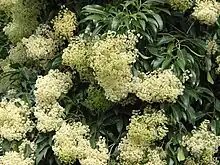Nuxia floribunda
Nuxia floribunda, the forest elder, forest nuxia or wild elder, is a species of tree in the Stilbaceae family, that is native to moist regions of southern Africa, East Africa and central tropical Africa.
| Nuxia floribunda | |
|---|---|
 | |
| Foliage and inflorescences | |
| Scientific classification | |
| Kingdom: | Plantae |
| Clade: | Tracheophytes |
| Clade: | Angiosperms |
| Clade: | Eudicots |
| Clade: | Asterids |
| Order: | Lamiales |
| Family: | Stilbaceae |
| Genus: | Nuxia |
| Species: | N. floribunda |
| Binomial name | |
| Nuxia floribunda | |
| Synonyms | |
| |
Description
It usually grows to between 3 and 10 metres tall, although it occasionally may grow as tall as 25 metres. It has a crooked trunk, rough flaking bark and a rounded canopy. Large panicles of sweetly scented small white to cream flowers are produced from autumn to spring.[2]
Range and habitat
The species is native to southern and eastern Africa, from South Africa, through Eswatini, Zimbabwe, Mozambique, Zambia, Malawi, Tanzania, Burundi, Rwanda, eastern Democratic Republic of the Congo, to Uganda and Kenya.[2][3][1][4]
It is a characteristic species of undifferentiated Afromontane forest in southern and eastern Africa.[5]
References
- Botanic Gardens Conservation International (BGCI) & IUCN SSC Global Tree Specialist Group. 2019. Nuxia floribunda. The IUCN Red List of Threatened Species 2019: e.T146221137A146221139. https://dx.doi.org/10.2305/IUCN.UK.2019-2.RLTS.T146221137A146221139.en. Accessed 3 December 2022.
- Burring, Jan-Hakon (August 2004). "Nuxia floribunda Benth". PlantZAfrica. Kirstenbosch National Botanical Garden, SANBI. Retrieved 1 July 2015.
- "Nuxia floribunda Benth". Flora of Zimbabwe. Retrieved 2009-10-26.
- Nuxia floribunda Benth. Plants of the World Online, Kew Science. Accessed 3 December 2022.
- White, Frank F. (1983). The vegetation of Africa: A descriptive memoir to accompany the Unesco/AETFAT/UNSO vegetation map of Africa. UNESCO, 1983. ISBN 92-3-101955-4
